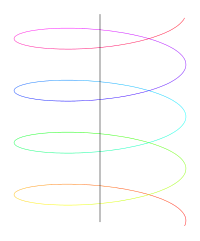Screw axis

Imagine you have a stick, and you want to rotate it around one end so it makes a circle. You can do this by twisting it around in your hand, but what if you don't want to use your hands? You could instead stick the stick into a board or a screw, and then turn the board or screw. As you turn it, the stick will rotate around itself and make a circle – this is what we call a screw axis.
A screw axis is when an object rotates around a line or an axis while also moving in a straight line along that axis. It's kind of like when you turn a screw into a piece of wood – the screw rotates but also moves forward. This movement is what makes a screw axis different from a regular rotational axis or a linear axis.
Screw axis is important in geometry and physics because it helps us understand the movement of objects in space, especially when it comes to things like rotational symmetry and coordination. It's used in fields like engineering, robotics, biology, and chemistry to design machines, model systems, and analyze data. So, next time you see a screw or turn a door knob, think about how it's moving along a screw axis!
A screw axis is when an object rotates around a line or an axis while also moving in a straight line along that axis. It's kind of like when you turn a screw into a piece of wood – the screw rotates but also moves forward. This movement is what makes a screw axis different from a regular rotational axis or a linear axis.
Screw axis is important in geometry and physics because it helps us understand the movement of objects in space, especially when it comes to things like rotational symmetry and coordination. It's used in fields like engineering, robotics, biology, and chemistry to design machines, model systems, and analyze data. So, next time you see a screw or turn a door knob, think about how it's moving along a screw axis!
Related topics others have asked about:
